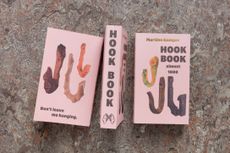Yves Behar on his design for good
On the occasion of his new monograph, Yves Behar: Designing Ideas, we talk to the Fuseproject founder on his career journey, technology and ‘the slow, winding journey of design’

Yves Behar founded Fuseproject in San Francisco 22 years ago. The Swiss designer has been closely associated with rapidly evolving tech products and services ever since. His journey from Swiss punk to design guru effectively mirrored Silicon Valley’s own evolution from a chaotic, DIY-infused alt-cultural ecosystem into the engine room of the world economy. On the way, Fuseproject has had triumphs and missteps, dead ends and diversions, but every project is infused with the utopian ethos that technology – done correctly – is a powerful force for good.
Yves Behar: Designing Ideas

Detail of the webbed back of the ‘Sayl’ office chair by Yves Behar for Herman Miller
A new design book, Yves Behar: Designing Ideas, charts the process behind his work, and is replete with images of prototypes and concept sketches. ‘Designing Ideas is not about a marketing solution – the final glossy picture – but showing the slow, winding road, the journey of design,’ says Behar. Rather than present Fuseproject’s output in chronological fashion, the book groups it into six sections: Reducing, Sensing, Transforming, Giving, Humanizing and Scaling. Each section captures Behar’s peerless ability to shape and direct how a product or service can best be streamlined for our new era of digitally driven, algorithmically guided consumption.
‘Designing Ideas is not about a marketing solution – the final glossy picture – but showing the slow, winding road, the journey of design’
Yves Behar
‘The strength of Fuseproject comes out of the original concept: to fuse disciplines together in the service of an idea,’ Behar says. ‘Being multidisciplinary is what creates these fully fledged solutions. The other thing that has always defined the studio is how we marry this approach to the world of start-ups, where everything has to be created from scratch.’
Yves Behar and the transformative power of design

The One Laptop Per Child project used as educational aid in an Afghanistan school
Although the turn of the century was a fertile time for start-up culture, vast numbers of ‘visionary’ ideas were never translated into physical form. ‘Design has had a tremendous evolution over the last 30 years,’ says Behar.
‘I came to Silicon Valley in the mid-1990s and design was not on the radar. Having studied in the European modern design tradition, I was interested in the opportunity to show how much value design could add to what were mostly engineered products. Design was seen as a decorative last-minute coat of paint.’
So what changed? The bursting of the first dotcom bubble was about the over-supply and over-valuation of services and platforms, rather than tangible, physical things. Ultimately, it would be studios like Behar’s that gave shape to the emerging genre of smart devices. ‘Design in the larger sense really became central to the success of a lot of companies,’ he says. ‘We experienced how it went from being an option to being an integral part of building a business.’

A sketch of the the $100 laptop of the One Laptop Per Child project
As the book’s sections imply, Behar believes strongly in design’s transformative power. ‘There are critical 21st-century ideas like sustainability, accessibility, and diversity, all of which can be accelerated by design,’ he says. As a designer, ‘you are in a position to influence new ideas and new behaviours. I believe design is about speeding up the adoption of new ideas.’ Some of Fuseproject’s highest profile works have addressed these issues. The One Laptop Per Child (OLPC) project, which ran from 2005 to 2014, aimed to create hundreds of millions of learning machines for children in the developing world, at $100 per piece. It was fuelled by optimism: ‘That project showed design reaching out to people who weren’t being addressed by the industry,’ says Behar, calling the challenge ‘a true design adventure of the highest order’ in the book. Although the scheme didn’t have the global impact OLPC first predicted, 3.5 million devices were built. ‘I think it demonstrated that education and the digital divide is still a world-changing issue,’ Behar reflects. ‘The actual device was a cascade of decisions towards simplicity.’
Other projects have similar pioneering components. The ‘Sayl’ office chair for Herman Miller showed that low-carbon-footprint design can have a global audience, Behar notes, and the book’s ‘Reducing’ chapter chronicles many different approaches to packaging, production and presentation, and the ways in which design can help less be more. ‘Design is not a linear path. You have to let the ideas and insights and discoveries inform the original premise,’ says Behar.
Wallpaper* Newsletter
Receive our daily digest of inspiration, escapism and design stories from around the world direct to your inbox.
Designing the tech experience

Designs for the keyless August home access system, which includes a smart lock, keypad and doorbell cam
Over the decades, the designer has also turned entrepreneur, not just shaping products but creating whole companies, such as August, a maker of home security systems that he co-founded with Jason Johnson in 2012. Advances in manufacturing and distribution have helped form this new ecosystem of smaller makers. ‘As a designer, to have your concept globally accepted is an amazing thing,’ he acknowledges.
Fuseproject has flourished during an era when the dumb physical object has been transcended by app-driven ‘smart’ devices, a product universe of tangentially related ‘things’. Behar is unrepentant about the transition, while insisting this is in the service of user experience. ‘I’ve always believed that tech should simply disappear. The experience should be only what someone sees and not what’s behind it,’ he says.
Newer products, like the ‘Snoo’ responsive baby cot, embody this belief in technology as a facilitator. ‘It’s wonderful to see how design can intersect with key life moments,’ Behar enthuses. ‘The cot shows how technology can address the needs of parents and babies. Although Snoo wasn’t designed to be a robot that looks after your baby, I’d use this image as a provocative idea, because ultimately our design is the opposite – it just looks like a beautiful object. The tech isn’t obvious.’

The ‘Snoo’ responsive baby cot, created in collaboration by Yves Behar and paediatrician Dr Harvey Karp
From 2015 to 2019, Fuseproject was a partner on the Spring technology accelerator programme, which supported entrepreneurs across East Africa and South Asia seeking to improve the lives of adolescent girls, and was developed with the Nike Foundation and the UK’s Foreign, Commonwealth & Development Office. Behar explains how the ethos of social enterprise is about reversing the traditional aid model in favour of funding and seeding local ideas. In Spring’s case, designing these support systems mattered far more than the physical appearance of objects.

A meeting for the Spring technology accelerator programme, with which Fuseproject partnered
That said, the object – however discreet, elegant, elaborate or connected – is here to stay. ‘The idea that software will kill the physicality of things has been around for quite a while. The truth is that it just hasn’t been the case,’ Behar says. ‘Software is in everything – even in [something as apparently simple as] our “Leaf” lamp for Herman Miller (2006). I see the technology and software as an ingredient, a tool, not the be-all and end-all. Sure, there are certain things that we are less and less inclined to physically own. But we will always be really excited about new form factors. I want to be a designer who puts the human connection at the very centre of people’s lives – that belief has always animated my work.
INFORMATION
Yves Behar: Designing Ideas, $85, published by Thames & Hudson, available from 20 July 2021
fuseproject.com
thamesandhudsonusa.com
Jonathan Bell has written for Wallpaper* magazine since 1999, covering everything from architecture and transport design to books, tech and graphic design. He is now the magazine’s Transport and Technology Editor. Jonathan has written and edited 15 books, including Concept Car Design, 21st Century House, and The New Modern House. He is also the host of Wallpaper’s first podcast.
-
 Three new coffee makers for a contemporary brew, from a casual cup to a full-on branded espresso
Three new coffee makers for a contemporary brew, from a casual cup to a full-on branded espressoThree new coffee makers, from AeroPress, Jura and Porsche x La Marzocco, range from the defiantly manual to the bells and whistles of a traditional countertop espresso machine
By Jonathan Bell Published
-
 Don't miss Luxembourg's retro-futuristic lab pavilion in Venice
Don't miss Luxembourg's retro-futuristic lab pavilion in VeniceAs the Venice Biennale enters its last few weeks, catch 'A Comparative Dialogue Act' at the Luxembourg Pavilion
By Amah-Rose Abrams Published
-
 A Berlin park atop an office building offers a new model of urban landscaping
A Berlin park atop an office building offers a new model of urban landscapingA Berlin park and office space by Grüntuch Ernst Architeken offer a symbiotic relationship between urban design and green living materials
By Michael Webb Published
-
 Discover the alchemy of American artists Philip and Kelvin LaVerne
Discover the alchemy of American artists Philip and Kelvin LaVerneThe work of Philip and Kelvin LaVerne, prized by collectors of 20th-century American art, is the subject of a new book by gallerist Evan Lobel; he tells us more
By Léa Teuscher Published
-
 20 pairs of bookends celebrate contemporary Scottish design and Dundee’s literary heritage
20 pairs of bookends celebrate contemporary Scottish design and Dundee’s literary heritageAs Dundee Design Week gets ready for its fifth edition, a bookish commission shines a light on two pioneering female journalists from the city’s storied past
By Alyn Griffiths Published
-
 ‘You’ve got to hang out with Judd furniture… you learn something’: Rainer Judd
‘You’ve got to hang out with Judd furniture… you learn something’: Rainer JuddAs new book ‘Donald Judd Furniture’ lands, the artist’s children Rainer and Flavin discuss their father’s legacy
By Diana Budds Published
-
 Discover London’s lesser-known design gems with ‘an opinionated guide’
Discover London’s lesser-known design gems with ‘an opinionated guide’‘An opinionated guide to Design London’ by Sujata Burman and Wallpaper’s Rosa Bertoli is a carefully curated tour of intriguing design spots across the capital
By Tianna Williams Published
-
 Well hung? We interview Martino Gamper about his new book of (around) 1,000 hooks
Well hung? We interview Martino Gamper about his new book of (around) 1,000 hooksItalian maverick designer Martino Gamper doesn't hang around. He has a new book featuring 1,000 hooks made by hand. We ask him how and why...
By Hugo Macdonald Published
-
 New Louis Poulsen book explores the Danish lighting company's illuminating world
New Louis Poulsen book explores the Danish lighting company's illuminating worldLouis Poulsen: First House of Light, published by Phaidon, is a new design book delving into the Danish company's world of radiant lighting
By Jens H Jensen Published
-
 ‘What We Keep’: 50 creatives on the objects they collect and use in their homes
‘What We Keep’: 50 creatives on the objects they collect and use in their homes‘What We Keep’ is a new book by Jean Lin, founder of the New York City design gallery Colony, an ode to objects and the people who obsessively collect them
By Diana Budds Published
-
 Sir Kenneth Grange’s influential industrial designs are chronicled in a new book
Sir Kenneth Grange’s influential industrial designs are chronicled in a new book‘Kenneth Grange: Designing the Modern World’ explores the life and work of the pioneering British industrial designer
By Jonathan Bell Published